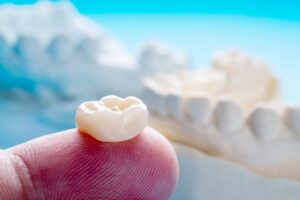Losing a dental crown can be unsettling, especially if it happens suddenly while eating or brushing your teeth. Although dental crowns are designed to be durable and long-lasting, they can occasionally come loose or fall off due to wear, decay, or adhesive failure. If this happens to you, don’t panic – there are clear steps you can take to protect your tooth and prevent further damage until you can see your dentist.
Step 1: Retrieve the Crown
If you notice your crown has come off, try to find and save it. Crowns can often be reused if they’re still in good condition. Rinse it gently with water and store it in a clean container. Do not try to reattach it using household glue, as this can damage both the crown and your natural tooth.
Step 2: Inspect Your Tooth
After removing the crown, examine your exposed tooth. If you see jagged edges or feel pain, your tooth may have fractured or been affected by decay. You might also experience sensitivity to hot, cold, or pressure, which is normal since the underlying tooth is now exposed.
Avoid touching or probing the area unnecessarily, as this can irritate the tooth or increase the risk of infection.
Step 3: Call Your Dentist
Contact your dentist as soon as possible to schedule a repair or replacement. Even if you’re not experiencing pain, an unprotected tooth is vulnerable to damage and decay. The sooner you’re seen, the more likely your original crown can be reused, saving you time and money.
Let the dental office know if you’re experiencing discomfort or if the tooth feels sharp, as they may be able to schedule you for an emergency appointment.
Step 4: Protect the Tooth Until Your Appointment
While waiting to see your dentist, take steps to protect the exposed tooth:
- Avoid chewing on that side of your mouth to prevent additional damage.
- Stick to soft foods that are less likely to irritate the area.
- Maintain good oral hygiene, brushing gently around the exposed tooth and rinsing with warm salt water to keep the area clean.
- Use temporary dental cement, available at most drugstores, if you feel comfortable doing so. This can help cover and protect the tooth temporarily, but it is not a long-term solution.
Step 5: Visit Your Dentist for Evaluation
During your appointment, your dentist will assess the tooth and crown. If the crown is intact and the tooth is healthy, they may be able to re-cement it. If the tooth has changed shape or if decay is present, you may need a new crown altogether.
Your dentist will also check why the crown came loose in the first place and may recommend additional treatment, such as repairing a damaged tooth structure or improving your bite alignment.
Losing a dental crown is inconvenient, but prompt action can minimize complications. Ignoring the issue can lead to pain, infection, or even the need for more extensive (and costly) procedures like a root canal or tooth extraction. If you act quickly and follow these steps, you can keep your smile safe and healthy until your crown is securely back in place.
About the Author
Dr. Ted Dunson has practiced dentistry for more than 25 years. He is a graduate of the Baylor College of Dentistry and has completed more than 100 cosmetic years over the years, including dozens of full mouth rehabilitations and smile makeovers. Dr. Dunson continues to stay current in his field with memberships in organizations including the American Dental Association and the Texas Dental Association. If you’ve experienced a situation where you’ve lost your crown, schedule your appointment now online or call our Denton office at (940) 566-4942.

